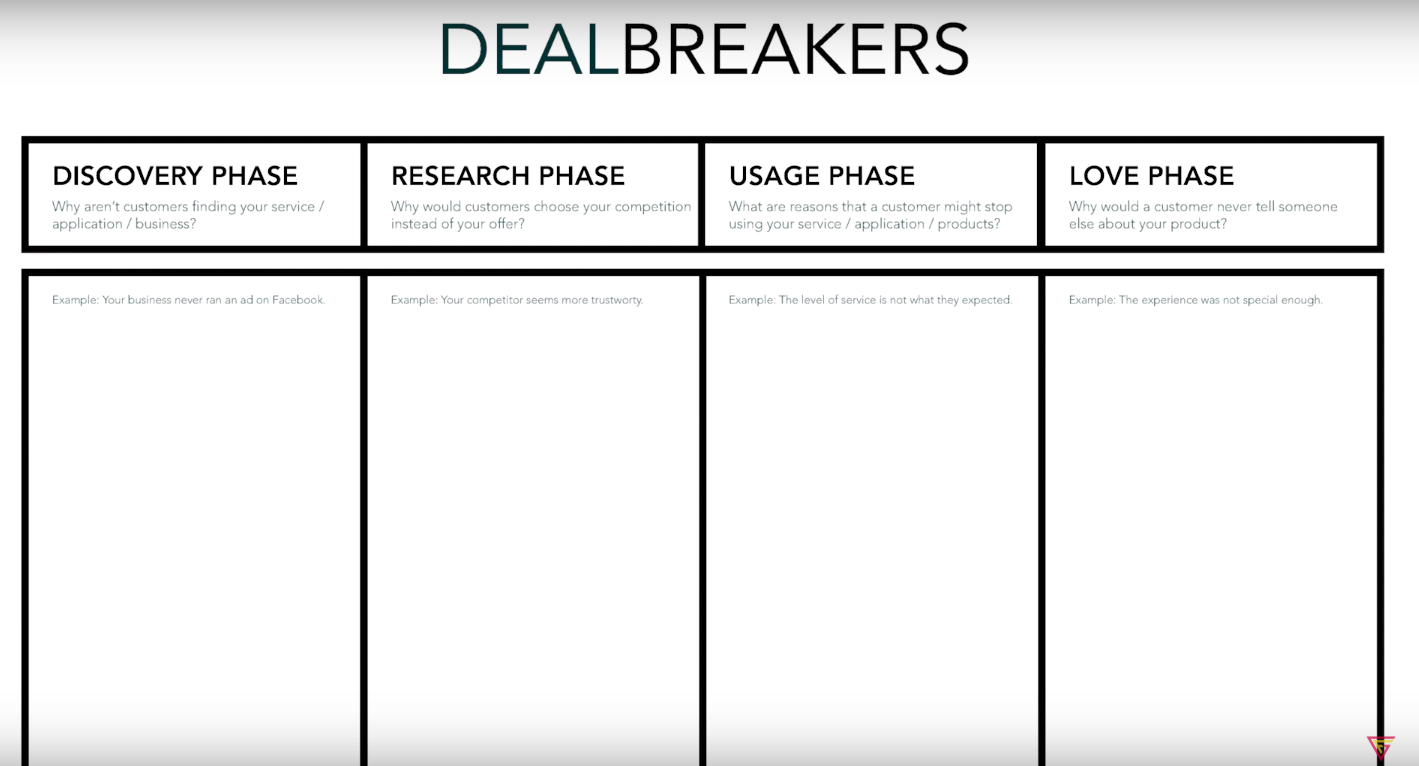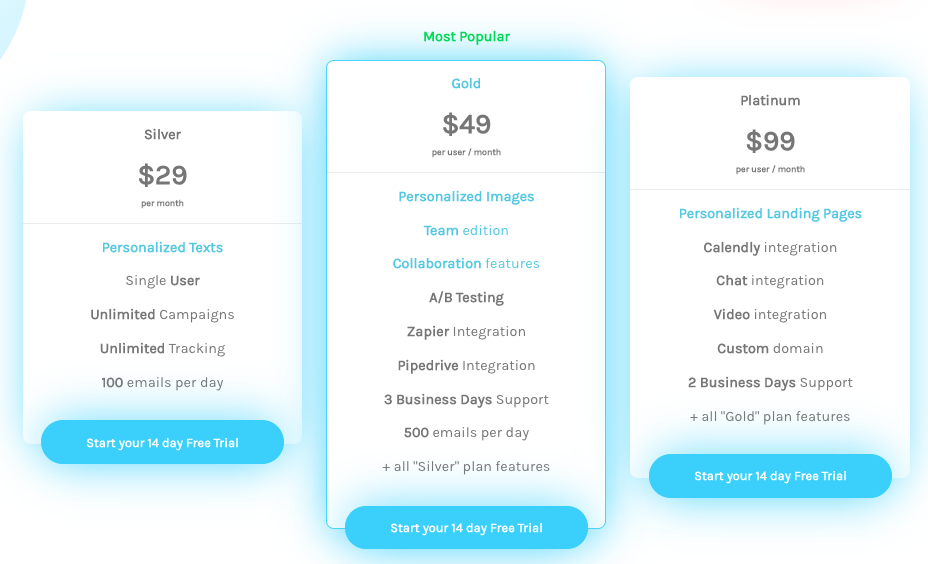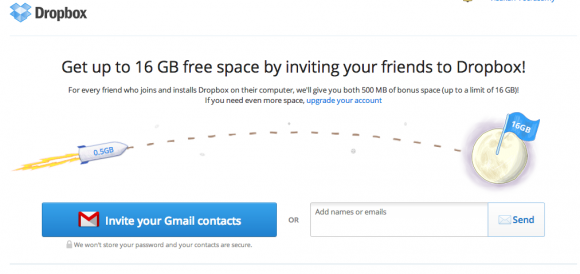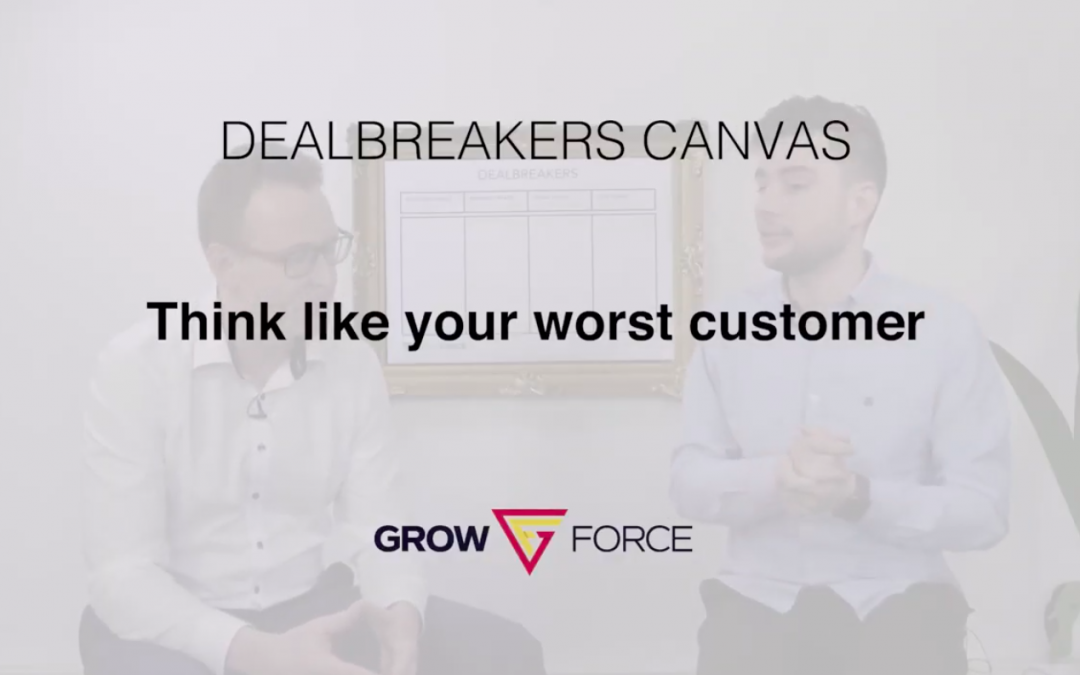One of the things we do best is thinking of the worst-case scenarios, and this is what all this marketing canvas about. What are all the things that can go wrong? What are all the reasons I can fail?
However, this time, we will transform this way of negative thinking to something genuinely positive for your company. At the end of the exercise, you’ll have plenty of ideas, growth marketing experiments, strategy changes, and small product iterations.
How to leverage “negative thinking” with the Dealbreakers Marketing Canvas
This exercise works best when you bring all different kinds of roles from your organization around the table. Some team-members you definitely need to invite: customer service, customer development, sales, and marketing people,.. Everyone has a unique perspective and has different touchpoints with customers. This often leads to very interesting insights.
Dealbreakers Marketing Canvas consists of four phases; let’s start with the first one.

Dealbreakers Marketing Canvas – The discovery phase
In this phase, you will try to find out why your potential customers don’t know that you exist.
You can think of all the online and offline reasons why this could be.
Here you find some of the more common examples:
- You never ran any online ads on Facebook, Google, Instagram, etc.
- You are not present in the most popular trade/marketing show of the year.
- You have never handed out a flyer.
- You’re not on Youtube, Facebook, LinkedIn or other social mediums.
- You never ran e-mailing campaigns.
- There is no real SEO-optimized website.
- You don’t produce content on your blog.
- And the list goes on.
Dealbreakers Marketing Canvas – The research phase
In this phase, your prospects already know that you exist, but they are exploring other solutions to solve their problem/pain. At some point in their buying cycle, your potential customers will probably compare your product with your competitors’.
Think as your competitors if they were your friends. But blunt friends that tell you the painful truths about you.
You can spot the missing pieces in your marketing strategy by listening to them. Even you can find out how they solved the same problems you have in the last months or years.
The catch of the research phase is to find out the areas that your competitors could outshine you. In other words: What are all the reasons your potential customers would choose your competitor over you?
Here are some ideas to get you started:
Credibility and trustworthiness
Your competitors have video testimonials, case studies, a youtube channel with tons of content, logos of their partners, a Quora account with 300 answers, and viral blog posts.
You need to convince your potential clients that you are an expert in your field. If you can’t cope with that, your prospects will choose your competitors on any given day.
Comparison page
Do your competitors have a comparison page that polishes their best services and features?
Maybe they even created some form of comparisons video, chart or SEO-optimized blog post.
You could create your own fair comparison chart that shows the value of your product and why it stands out in the fierce competition. However, you don’t need to show every single thing 😉
Pricing
Spy on your competitors’ pricing pages. Check their prices, subscription plans, images, copy and CTA’s.
After you check all your competitors, go on and check some famous brands too. Find out what works well, tweak, and use them in your favor.
Leave no space for confusion. Be tangible, clear, and transparent with your pricing.
Here, check how simple lemlist’s pricing page is.

Value Proposition
Your visitors spend between 3-5 seconds to understand the service or product you are offering. Test your page to see if your audience understands the core message.
Quick growth tip: Ask your friends to look at your website for 5 seconds. Then ask them 2 simple questions; “What is the product/service that this website wants to sell?” and “What makes them unique?”
It’s one of the most crucial elements because you never get a second chance to make a first impression. To get you started, we covered how to find a compelling value proposition in 4 steps.
Dealbreakers Marketing Canvas – The usage phase
In this phase, your customer is already on-boarded. He downloaded your software, signed up or simply bought your product. However, he stopped using your product.
Now, we will focus on the question, “Why would a customer stop using our product?”. Well, there could be hundreds of reasons.
We’ll help you out with some ideas to start your brainstorming session.
Your product is not easy to use
Some products have a learning curve and complicated features.
Maybe your customers truly wanted to use the product, but they got lost in the process.
It was hard to use, the UX(User Experience) was unclear, the product didn’t work as they expected and so on. If you could see what the problem is, the solution will come naturally.
Is it hard to use? Then create a how-to series to help your customers. UX is not clear? Redesign and test it.
Products can be complicated by nature; however, there is always a way to make your customers stay.
They forgot about your service
Why would customers stop using your service?
Maybe you didn’t make any effort to keep them interested.
- No e-mails
- No heartwarming welcome message
- No drip campaign about your features.
- No tempting promotions
- No newsletters
- Briefly, no wow moments.
If your customers forgot about your service, it’s not their fault. You need to do something to earn their attention.
Create a journey for your customers and start nurturing them. Create an engaging newsletter, educational webinar, promotional drip e-mail campaign to keep in touch with them.
Dealbreakers Marketing Canvas – The love phase
True love in marketing is a referral, and love is a complicated matter.
There are two types of love in this phase of the canvas, and the question to ask is: “Why would they not tell anyone about my product?”.
Love love:
A “lover” uses your product all the time without a complaint. He is happy to be with you, but he never tells about you to another person. But why?
Well maybe,
- You don’t have a referral system.
- There are just not even shareable bits: like interesting results generated with your product.
- There is no content, such as blog posts, ebooks or cheat sheets
Like love:
A “liker” uses your product on a daily basis but he never experienced a wow moment. You can offer mutually beneficial referrals to them as Dropbox, Groupon and Revolut did.
Dropbox achieved hyper-growth with a referral program that gave users 500mb free space when someone signed up through their link. The person on the other side would kickstart his Dropbox journey with 500mb extra as well.

Source: Dropbox
How much time do you need to spend with the Dealbreakers Marketing Canvas?
This exercise is one of the first things we do when we start to work with a customer.
We ran this experiment numerous times. Each session brought hundreds of insight and solutions to the table. It works. Especially, ıt works well for organizations like SMEs and Startups.
One thing is crucial for this exercise: the number of people. Why?
Here is a simple equation:
More people = More negative thinking = More ideas to experiment.
In our sessions, we spend three minutes per phase and encourage people to write down what is top of mind.
Once you map your problems on the dealbreakers marketing canvas, you’ll uncover what is missing in your marketing, product or distribution strategy. Then you can transform all these negative thoughts into opportunities.
Now it’s your turn, start filling your Dealbreakers marketing canvas with your most negative ideas.
You can print the Dealbreakers Marketing Canvas and put it on your wall or you can access it digitally here:
Log in to your free Dealbreakers Marketing Canvas
Also, you can watch our Dealbreakers Marketing Canvas video on Youtube.
GrowForce joins Customer Collective: our team and offering become part of Upthrust
It’s official: GrowForce joins Upthrust, one of the 5 driving forces behind the international professional services group Customer Collective. As a...
Content Distribution: How to Do It Right?
The content distribution marketplace has become one of the most competitive spaces in marketing. You need to release content more often than ever before to stay relevant. This post will outline the right ways to distribute content for maximum effects.
The Benefits Of Machine Learning On Your Ecommerce Business
What are the benefits of machine learning on your e-commerce business




